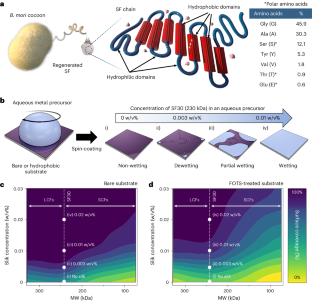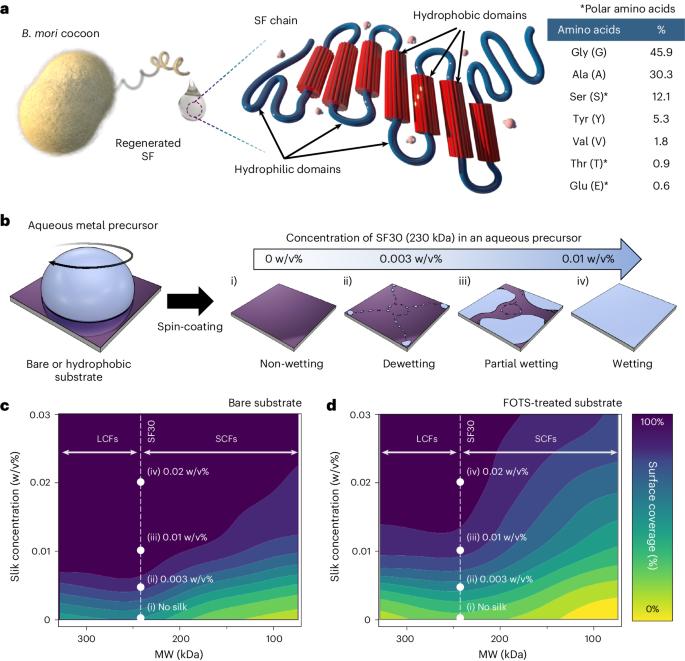丝纤维素作为水基纳米制造的表面活性剂
IF 38.1
1区 材料科学
Q1 MATERIALS SCIENCE, MULTIDISCIPLINARY
引用次数: 0
摘要
水基加工在高科技领域,尤其是电子学、材料科学和生命科学领域发挥着至关重要的作用,对开发高质量的可靠设备、提高制造效率、安全性和可持续性具有重要影响。在微米和纳米尺度上,水是连接生物和技术系统的独特桥梁。然而,水的高表面张力阻碍了生物纳米界面的润湿和制造,因此需要新的方法来克服由此带来的根本性挑战。在此,我们报告了使用丝纤维素作为表面活性剂来实现纳米级设备的水基加工。即使是微量(例如 0.01 w/v%),丝纤维素也能大大提高表面覆盖率,在精确控制水基溶液与疏水性表面之间的界面能方面优于商用表面活性剂。这种效果归因于蚕丝分子的两亲性及其对具有不同表面能的基质的适应性吸附,从而促进了不可能配对的材料之间的分子间相互作用。通过制造从晶体管到光伏电池的水处理纳米器件,凸显了这种方法的多功能性。其性能与类似的真空处理设备相当,突出了这种方法在水基纳米制造方面的实用性和多功能性。本文章由计算机程序翻译,如有差异,请以英文原文为准。


Silk fibroin as a surfactant for water-based nanofabrication
Water-based processing plays a crucial role in high technology, especially in electronics, material sciences and life sciences, with important implications in the development of high-quality reliable devices, fabrication efficiency, safety and sustainability. At the micro- and nanoscale, water is uniquely enabling as a bridge between biological and technological systems. However, new approaches are needed to overcome fundamental challenges that arise from the high surface tension of water, which hinders wetting and, thus, fabrication at the bio–nano interface. Here we report the use of silk fibroin as a surfactant to enable water-based processing of nanoscale devices. Even in minute quantities (for example, 0.01 w/v%), silk fibroin considerably enhances surface coverage and outperforms commercial surfactants in precisely controlling interfacial energy between water-based solutions and hydrophobic surfaces. This effect is ascribed to the amphiphilic nature of the silk molecule and its adaptive adsorption onto substrates with diverse surface energy, facilitating intermolecular interactions between unlikely pairs of materials. The approach’s versatility is highlighted by manufacturing water-processed nanodevices, ranging from transistors to photovoltaic cells. Its performance is found to be equivalent to analogous vacuum-processed devices, underscoring the utility and versatility of this approach for water-based nanofabrication. The amphiphilic nature of silk fibroin makes it a natural surfactant. Here it is shown to mediate interface interactions, enabling the wetting of hydrophobic surfaces with aqueous solutions and facilitating water-processed nanodevice fabrication without previous surface modification.
求助全文
通过发布文献求助,成功后即可免费获取论文全文。
去求助
来源期刊

Nature nanotechnology
工程技术-材料科学:综合
CiteScore
59.70
自引率
0.80%
发文量
196
审稿时长
4-8 weeks
期刊介绍:
Nature Nanotechnology is a prestigious journal that publishes high-quality papers in various areas of nanoscience and nanotechnology. The journal focuses on the design, characterization, and production of structures, devices, and systems that manipulate and control materials at atomic, molecular, and macromolecular scales. It encompasses both bottom-up and top-down approaches, as well as their combinations.
Furthermore, Nature Nanotechnology fosters the exchange of ideas among researchers from diverse disciplines such as chemistry, physics, material science, biomedical research, engineering, and more. It promotes collaboration at the forefront of this multidisciplinary field. The journal covers a wide range of topics, from fundamental research in physics, chemistry, and biology, including computational work and simulations, to the development of innovative devices and technologies for various industrial sectors such as information technology, medicine, manufacturing, high-performance materials, energy, and environmental technologies. It includes coverage of organic, inorganic, and hybrid materials.
 求助内容:
求助内容: 应助结果提醒方式:
应助结果提醒方式:


